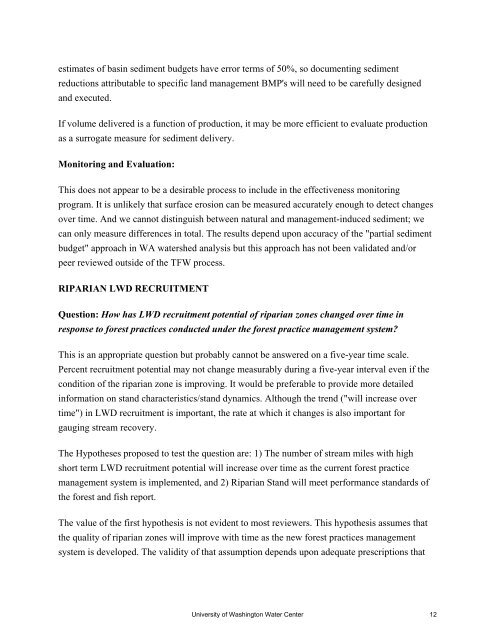Review of the TFW Monitoring Program.pdf
Review of the TFW Monitoring Program.pdf
Review of the TFW Monitoring Program.pdf
You also want an ePaper? Increase the reach of your titles
YUMPU automatically turns print PDFs into web optimized ePapers that Google loves.
estimates <strong>of</strong> basin sediment budgets have error terms <strong>of</strong> 50%, so documenting sediment<br />
reductions attributable to specific land management BMP's will need to be carefully designed<br />
and executed.<br />
If volume delivered is a function <strong>of</strong> production, it may be more efficient to evaluate production<br />
as a surrogate measure for sediment delivery.<br />
<strong>Monitoring</strong> and Evaluation:<br />
This does not appear to be a desirable process to include in <strong>the</strong> effectiveness monitoring<br />
program. It is unlikely that surface erosion can be measured accurately enough to detect changes<br />
over time. And we cannot distinguish between natural and management-induced sediment; we<br />
can only measure differences in total. The results depend upon accuracy <strong>of</strong> <strong>the</strong> "partial sediment<br />
budget" approach in WA watershed analysis but this approach has not been validated and/or<br />
peer reviewed outside <strong>of</strong> <strong>the</strong> <strong>TFW</strong> process.<br />
RIPARIAN LWD RECRUITMENT<br />
Question: How has LWD recruitment potential <strong>of</strong> riparian zones changed over time in<br />
response to forest practices conducted under <strong>the</strong> forest practice management system?<br />
This is an appropriate question but probably cannot be answered on a five-year time scale.<br />
Percent recruitment potential may not change measurably during a five-year interval even if <strong>the</strong><br />
condition <strong>of</strong> <strong>the</strong> riparian zone is improving. It would be preferable to provide more detailed<br />
information on stand characteristics/stand dynamics. Although <strong>the</strong> trend ("will increase over<br />
time") in LWD recruitment is important, <strong>the</strong> rate at which it changes is also important for<br />
gauging stream recovery.<br />
The Hypo<strong>the</strong>ses proposed to test <strong>the</strong> question are: 1) The number <strong>of</strong> stream miles with high<br />
short term LWD recruitment potential will increase over time as <strong>the</strong> current forest practice<br />
management system is implemented, and 2) Riparian Stand will meet performance standards <strong>of</strong><br />
<strong>the</strong> forest and fish report.<br />
The value <strong>of</strong> <strong>the</strong> first hypo<strong>the</strong>sis is not evident to most reviewers. This hypo<strong>the</strong>sis assumes that<br />
<strong>the</strong> quality <strong>of</strong> riparian zones will improve with time as <strong>the</strong> new forest practices management<br />
system is developed. The validity <strong>of</strong> that assumption depends upon adequate prescriptions that<br />
University <strong>of</strong> Washington Water Center 12
















